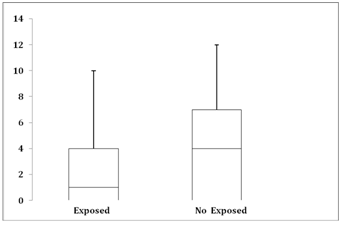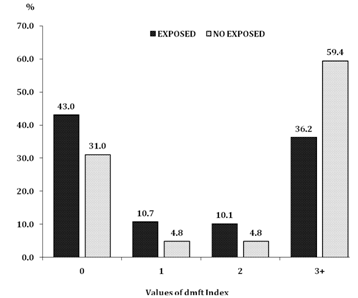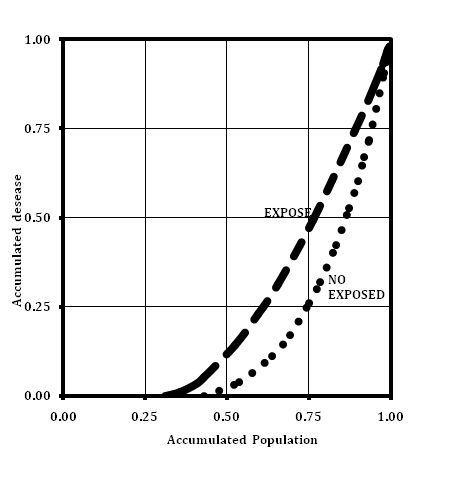MOJ
eISSN: 2379-6383


Research Article Volume 7 Issue 4
Department of Politics, São Paulo University, Brazil
Correspondence: Mariângela Guanaes Bortolo da Cruz, Department of Politics, Management and Health of Public Health College of São Paulo University, Rua Roquete Pinto 313, Butantã, São Paulo, CEP 05515 010, Brazil, Tel +55-11-9-9279-6898
Received: April 21, 2018 | Published: July 6, 2018
Citation: Cruz MGB, Narvai PC. Caries behavior in deciduous dentition and fluoridated water. MOJ Public Health. 2018;7(4):169?172. DOI: 10.15406/mojph.2018.07.00223
Background: There is no evidence that fluoridation of public water supplies generates a preventive benefit in relation to dental caries, to those provided by the widespread use of fluoridated dentifrices; especially on the deciduous dentition, a current challenge in the field of Oral Health in the regions of the Americas and the Caribbean.
Objectives: To analyze the degree of the preventive benefit of exposure to fluoridated water in relation to caries in the deciduous dentition.
Methods: A double census population survey was conducted in two Brazilian cities, in 5 and 6years old children (N= 233), immersed in their exposure (Silveiras, N= 149) or not exposure (São José do Barreiro, N= 84) condition to fluoridated water, from 2009 to 2014. The experience, magnitude and degree of caries polarization were evaluated using the dmft index and the association was tested using Pearson's chi-square statistics and prevalence ratio (PR) between not exposed (NE) and exposed (E).
Results and discussion: Although caries experience (dmft≥1) was not associated with exposure to fluoridated water (chi-square= 2.77, p=0.96, α=5%), there was a significant difference in the magnitude which the disease reached the population: the mean dmft were 2.74 in those exposed and 4.17 in those not exposed. The degree of polarization, indicated by the percentage of individuals with dmft =0, was different, being higher (43.0%) in those exposed and lower (31.0%) in those not exposed. PR (NE/E) was 1.21 indicating that exposure to fluoridated water corresponded to a 21% lower prevalence rate, compared to those not exposed.
Conclusion: Exposure to fluoridated water implied a lower mean value of the dmft index, even in the presence of the concomitant exposure to fluoridated dentifrice.
Keywords: public health, oral health, dental caries, fluoridation, primary dentition
Caries is a disease of complex etiopathogenesis resulting from multiple risk factors. With an unequal prevalence in populations, it is not only the result of biological variations derived from the parasite-host relationship, but also from the social differences between people. Is still considered the greatest challenge of Oral Health.1–4 Untreated caries in deciduous dentition is one of the ten most prevalent pathological conditions in children, affecting around 600 million, in 2010.5 Significant reductions have been found in the prevalence and severity of dental caries in school-aged children in industrialized countries.6,7 But, in England, Wales and Arab Emirates, studies pointed out that proportion of untreated caries in the deciduous relative to the permanents is higher in poor communities, mainly where children are not exposed to fluoridation of public water supply.6–8 In the meta-analysis that included 75 studies on the prevalence of caries in Latin America (including Brazil) and the Caribbean, since the beginning of the 21st century, it was found that more than 50% of children aged 5 and 6 years are affected by the disease.9 Caries in primary teeth has remained a major public oral health challenge in these American regions. In addition to the known risk factors represented by a diet rich in sugars, poor oral hygiene, low maternal schooling and poverty, the familiar perception of the transience of this dentition is added.10–12
The Brazilian context demonstrated by the last National Oral Health Survey, conducted in 2010, pointed out eight of ten decayed deciduous teeth are not treated. Therefore, effective protective measures in the prevention of the disease have extreme health relevance.10–13 In 1998, in Blumenau, municipality of southern Brazil, significant differences were found in the prevalence and severity of caries in schoolchildren aged 6 to 12years, when comparing students who attend public and private schools. Private school students had better oral conditions.10,11 In 2006, when studying the individual and contextual determinants of the need for dental treatment in the deciduous dentition in Brazil, using the 2003 National Oral Health Survey, it was found that black children, rural dweller and public school students possessed the highest percentages of untreated decayed deciduous teeth.12,13 These searches show that also in Brazil, health conditions, poor oral health status and need for dental treatment are closely associated with the socioeconomic context in which people are inserted.14–16
The discovery of the preventive effect of fluoride made it, throughout the 20th century, the main agent used in coping with dental caries. Fluoride dentifrices, widely marketed since the end of the 1980s, as well as the fluoridation of water supply, which has been compulsory since 1974, stand out as the main preventive methods used against the disease in Brazil.17–19 Given the proven preventive efficacy of fluoridated dentifrices, there is an interest in examining whether, in contexts where the use of such products is widespread, the preventive efficacy of fluoridation of public supply water remains or whether, on the contrary, neutralized or reduced to insignificant levels.20–22 The objective of the present study was to verify in two small municipalities of the Southeast region of Brazil, whose populations have universal access to fluoridated dentifrices, caries behavior in the deciduous dentition, through exposure to fluoridated water.
Design
Aiming to analyze caries behavior in the deciduous dentition, through exposure or not to fluoridated water, two simultaneous cross-sectional observational studies of the census type were performed. The primary data were obtained in november of 2014. The period considered for exposure or not to fluoridation of public water supply was from 2009 to 2014 (for at least Fiveyears). Two extremely similar cities were chosen, that differed only by the fluoridation or not of the public supply, in order to compare the behavior of caries in children under action or not in water fluoridation.
Study area
Among the brazilian municipalities that met and did not meet the criteria of exposure to fluoridation and whose social spaces fulfilled the requirement of similarity adopted in this research, practically identical in geographic, financial, social and cultural aspects, the municipalities were selected. Both met the criterion to be constituted in similar "social spaces" paired a priori, capable of generating population parameters obtained through two simultaneous censuses, directly comparable.16 The cities belong to southeastern Brazilian region, state of São Paulo, which had or not had correct and continuous fluoridation were Silveiras and São José do Barreiro, respectively. The distance between the cities is 47km and no municipality “invades” them, which is quite common in large urban centers and their surrounding metropolitan areas. São José do Barreiro and Silveiras are also similar in the environmental and historical aspects. They have an extensive territory with large rural areas. Both were founded at the end of eighteenth century, being old areas of coffee cultivation, rich cities in the eighteenth and nineteenth centuries, lost economic relevance and became impoverished municipalities in the twenty-first century with economic and social dynamics in the commerce, agriculture and tourism.
Study participants
With the objective of analyzing the behavior of caries in deciduous dentition, through exposure or not to water fluoridation, whose populations have universal access to fluoridated dentifrices, all children of 5 and 6years old were examined in both municipalities (N=233). A group of 149 children was exposure and 84 was not exposure to fluoridated water. The criterion for individual exposure to fluoridated water was to reside, for at least 5years (from 2009 to 2014) in the same address. All children examined daily used fluoridated dentifrice.
Study tools and procedures
The calibration technique of the 4 field teams, composed by dentists and annotators, was performed with Kappa interexaminer (K =0.97-0.98) and intraexaminer (K =0.98-1.00), considered to be optimal.23 Oral examinations were performed in all school units obeying the criteria of the World Health Organization for epidemiological surveys in oral health.23 The teams made systematic returns to schools, according to the method, seeking to exhaust the possibilities of including all children. Losses were less than 2%, mainly resulting from the explicit refusal from the parents and repeated absences from school. Thus, we set up the census aspect of this research.
Study analysis
Data processing was performed using the Epi-Info software. The experience and magnitude of dental caries in children exposed and not exposed to water fluoridation was evaluated using the dmft index. We measured the scaling of the difference in the prevalence between exposed and not exposed using the prevalence ratio (PR) and we tested the exposure-disease association Pearson's chi-square statistics.
Ethical clearance
The research was approved by the Brazilian National Ethics Committee with CAAE process 34299614.7.00005421.064944/2014, recognized by the CEP/CONEP system, before the beginning of the field stage, according to Brazilian regulations.24
The value of the dmft index was 2.74 (SD=3.50) for those exposed to fluoridated water and 4.17 (SD=3.50) for those not exposed (Table 1). Mode was 0.0 in both distribution and the median was 1.0 for those exposed and 4.0 for those not exposed. The amplitude of variation was 13 for those exposed and 12 for those not exposed. The coeficiente of variation was 1.28 for those exposed and 0.84 for those not exposed (Figure 1). The box plot shows the patterns of variability of the two populations. It shows that diferente magnitudes represented by the values of dmft index were not from aberrante values, the non-occurrence of outliers (Figure 1). The percentage of individuals without caries experience was 43% in those exposed and 31% in those not exposed. Already, the percentage of children with three or more caries was 36.2% in those exposed and 59.4% in those not exposed (Figure 2). Both those exposed and not exposed presented distributions marked by moderate internal inequality (Figure 3). The Lorenz curves for those exposed and not exposed corresponded to Gini Coefficients of 0.6574 and 0.4835, respectively. We observed a curve for those exposed, greater inequality in the distribution of the disease, indicating more polarization, compared to the curve corresponding to those not exposed. This characteristic of the distributions of dmft values in the exposed and no exposed populations is also expressed in the mean values of the dmft index. The PR between those not exposed and those exposed (PR=NE/E) was 1.21, indicating little expressiveness in prevalence difference. The chi-square value (2.777; p=0.96, α = 5%) indicated that the prevalence difference cannot be attributed to the exposure to the preventive measure.
Index |
Exposure to fluoridated water |
|||||
Yes |
No |
|||||
N |
Average |
% |
N |
Average |
% |
|
Dmft |
409 |
2.74 |
100 |
350 |
4.17 |
100 |
decayed |
273 |
1.83 |
66.8 |
285 |
3.39 |
81.3 |
missing |
6 |
0.04 |
1.4 |
2 |
0.03 |
0.7 |
filled |
130 |
0.87 |
31.8 |
63 |
0.75 |
18.0 |
Table 1 dmft index and components for 5 and 6years old chindren, according to exposure to water fluoridation. Silveiras (with fluoridation) and São José do Barreiro (without fluoridation), state of São Paulo, Brazil, 2014.

Figure 1 Box Plot of the distribution of the values of dmft índex, in children aged 5 and 6years, according to exposure to fluoridated water. Silveiras (with fluoridation) and São José do Barreiro (without fluoridation), state of São Paulo, Brazil, 2014.

Figure 2 Percentage distribution of the values of the dmft index, in children aged 5 and 6years, according to exposure to fluoridated water. Silveiras (with fluoridation) and São José do Barreiro (without fluoridation), state of São Paulo, Brazil, 2014.

Figure 3 Lorenz curves for load distributions of dental caries in children aged 5 and 6years, according to exposure to fluoridated water. Silveiras (with fluoridation) and São José do Barreiro (without fluoridation), state of São Paulo, Brazil, 2014.
Discussion on findings
This research is the first one carried out in Brazil and Latin America, that consists of two epidemiological population censures in children differentiated only according to exposure or not to public water fluoridation. In Latin America, including Brazil and the Caribbean, since the beginning of the 21st century, it was found that more than 50% of children aged 5 and 6years are affected by the dental caries, the major public oral health challenge in these regions. The study is made up of two simultaneous cross-sectional studies, that have limitations. One is that, they observe one moment in time and cannot, therefore, measure the time of exposure to variables that may be associated with the observed outcomes. The results demonstrate that eight out of ten deciduous decayed teeth are not treated in those not exposed to fluoridated water, the same proportion as the 80% of untreated decayed primary teeth recorded by the Brazilian Oral Health Survey, 2010. Those exposed to fluoridated water this proportion is 67%. However, it is noteworthy that in both populations analyzed, the great majority of decayed primary teeth remain without receiving any dental treatment, in 2014 (Table 1). These data reiterate the challenge of dental caries without treatment, especially in children.
The median is 1.0 for those exposed and 4.0 for those not exposed, indicating the worst condition of the disease for those not exposed (Figure 1). Those exposed to water fluoridation 43.0% were free of caries, while those not exposed 31.0%. At the most heavily loaded pole of the disease, 36.2% of those exposed to fluoridation of water have three or more teeth affected, while those not exposed 59.4% (Figure 2). These results point to the efficacy of water fluoridation as a preventive measure, and in a context of poverty and difficult access to dental services gains fundamental importance. The value (4.17) of dmft index obtained for those not exposed is 52% highter than the value (2.74) obtained for those benefited by water fluoridation, even though both children populations were exposed to the fluorides in toothpaste in these cities. This difference (52%) represents a original information of great value in Brazilian situation, marked by important health inequalities. Such admission results from this research and the available knowledge about Brazilian demographic and health reality.
Public water fluoridation was identified as environmental variable to explain the lower magnitude of the dmft índex among those exposed to the measure. Exposure to fluoridated water implied a lower mean value of the dmft index at a level of 52%, although in the presence of concomitant universal exposure to fluoride dentifrice.
Fluoridation of public water supply promotes relevant epidemiological effects in the Brazilian context, with health inequities, in which dental caries in primary teeth has remained a challenge for Oral Health not only in the country, but also throughout Latin America and the Caribbean.
None.
The authors declare that there is no conflict of interest.

©2018 Cruz, et al. This is an open access article distributed under the terms of the, which permits unrestricted use, distribution, and build upon your work non-commercially.
 International Universal Health Coverage Day is observed every year on December 12th to highlight the urgent need for affordable, quality health care for everyone. The 2025 theme is “Unaffordable health costs? We’re sick of it!”—a rallying cry to strengthen health systems and ensure no one is left behind. On this occasion, UHC supporters worldwide raise their voices to share the stories of millions still waiting for care. MedCrave Online Journal of Public Health welcomes researchers to contribute articles on the importance of health, offering a 40% discount on submissions to encourage knowledge-sharing and progress.
International Universal Health Coverage Day is observed every year on December 12th to highlight the urgent need for affordable, quality health care for everyone. The 2025 theme is “Unaffordable health costs? We’re sick of it!”—a rallying cry to strengthen health systems and ensure no one is left behind. On this occasion, UHC supporters worldwide raise their voices to share the stories of millions still waiting for care. MedCrave Online Journal of Public Health welcomes researchers to contribute articles on the importance of health, offering a 40% discount on submissions to encourage knowledge-sharing and progress.